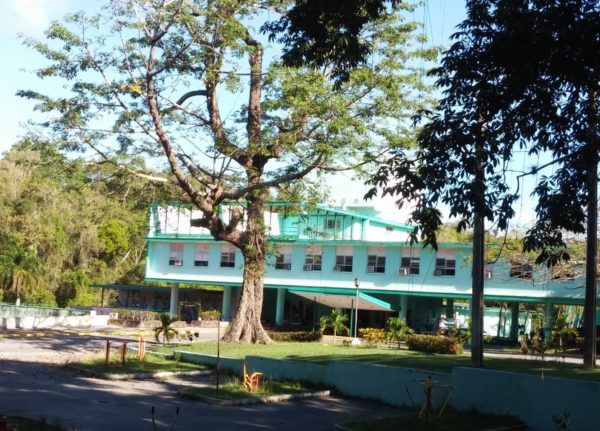Is San Diego de los Baños, Cuba Still a Magical Town?

By Fabiana del Valle
HAVANA TIMES – San Diego de los Baños is located at the foot of Sierra del Rosario, in the Pinar del Rio province. It has a microclimate with cool temperatures because of its elevation. Its streets are settings to admire the splendid views, as the city center is harmoniously placed within the natural environment.
Despite the corresponding authorities’ neglect and incompetence, buildings of great architectural and historic value remain. Empty organiponicos (organic urban vegetable gardens) or empty stores take up the space that hotels once took, which made the town one of the most visited on the island.
Locals here believe that San Diego has a mysterious magnet that attracts anyone who visits and never lets them leave. An almost magical power that is granted by the evolution of its history and the miraculous discovery of its medicinal waters.
I started researching and discovered the mystique of this place in many historic documents. Legend has it that there was a slave called Taita Domingo on the San Pedro de las Galeras ranch. One day, he discovered lesions all over his body that only got worse over time, as he had to go out and work in this condition. When the ranch’s foremen noticed his ailment, they told the owner. He in turn ordered that Taita be expelled as he was afraid that the rest of the personnel would become infected.
Alone and with nowhere to go, he began to wander around the outskirts of the ranch, waiting for Death to come calling. He went to the river to cool down and wash his wounds. There, he discovered a hot water spring that relieved his physical discomfort. That was how he completely recovered, and he went back to the ranch to attest to the miracle.
News of the miraculous water spread from town to town. Many locals with skin conditions or other ailments wanted to have the same fate as Taita. That’s how the fame of the Caiguanabo River’s mineral/medicinal waters spread across the entire island.
At the beginning of spring, people would come to the baths and improvise ranches and huts, which were them destroyed at the end of the season. That’s how people began to settle in what would come to be called “Baños de San Diego”.

In 1838, the hamlet of San Diego had 72 mud-caked and guano roofed houses. A drugstore, four taverns, five assorted stores, a bakery, a pool cafe, a shoe store, a carpenter’s, two tobacco manufacturing businesses and a school. All for a population of 119 people, who were living there on a permanent basis.
I also discovered that during this time, Cirilo Villaverde visited the place with French painter Alexandre Moreau. His impressions were recorded in the book “Excursion to Vuelta Abajo”, which was published in 1839.
In 1844, the town’s urban layout was drawn up. That’s how it began, with traders and neighbors competing to replace old shacks with new buildings.
Over the years, the palm leaf or mud ranches with palm leaf roofs disappeared, which Cirilo Villaverde had seen on his trip and which doctor Francisco Antomarchi (Napoleon Bonaparte’s private doctor) described in a memoir sent to Captain general Miguel Tacon on April 11, 1837.
The first hotels began to be built at a growing pace. In 1842, the Cabarrouy Hotel opened its doors, which has remained within the family as a property and business, for many decades. Then, the Hotel Bardino and Casa Soto opened. There were also the Cabancho, Bustamente, Soler, Evora and Julve Hotels.

There are noteworthy precedents from reliable sources that assure that Baron Don Alejandro de Humboldt, Carlos Manuel de Cespedes, Francisco Vicente Aguilera and Miguel de Aldama came here to visit. Ignacio de Agramonte y Loynas also stayed at the Cabarrouy Hotel for a stretch of time, and he wrote a total of nine letters to his wife Amalia Simoni from here. It’s precisely at the Cabarrouy Hotel that the distinguished Esteban Borrero Echeverria decided to take his life on March 29, 1906.
Top athletes such as Eligio Sardiñas (Kid Chocolate) or Gustavo Mustelier (Kid Tunero), both world boxing champions visited. Writers and poets such as Gertrudis Gomez de Avellaneda, who preferred the Cabarrouy Hotel on every trip, Tranquilino Sandalio de Noda and Dulce Maria Loyna, the latter a Cervantes Literature prize winner and the internationally-renowned and distinguished composer Gonzalo Roig, who said he had much to thank San Diego for.
While people used to come here to seek relaxation and a cure in the blessed waters that bathe the town, many people today are upset about the precarious situation it’s currently in. The landscape has become bleaker with blackouts, shortages of basic essentials, exorbitant prices and this never-ending disease that takes many of its residents every day.
This town that arose thanks to its miraculous waters, which was classified as one of the most beautiful places in Cuba and called the “Saratoga Springs of the Tropics” by Samuel Nazaro in his book “Cuba a Pluma y Lapiz”, is a town that is now wilting.
Has San Diego de los Baños lost its magic? Is there no longer a miracle to save it?






Comments are closed.